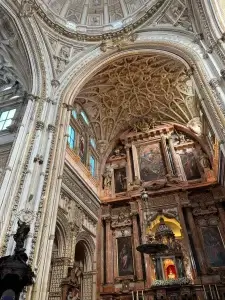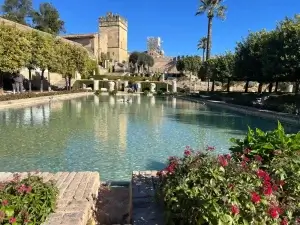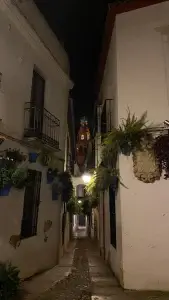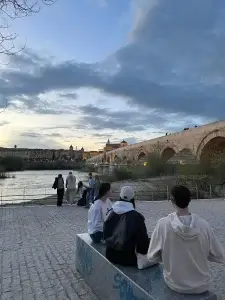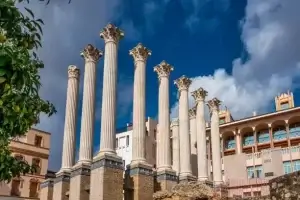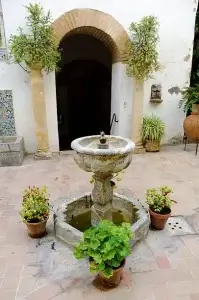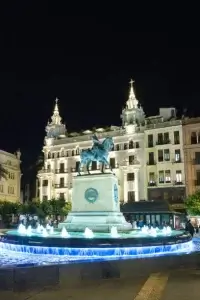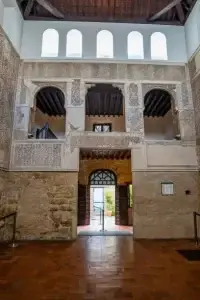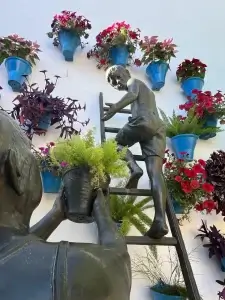En este post podrás leer:
Day 1: The most iconic monuments to see in Cordoba in two days
On your first day exploring the streets of Cordoba, both well-known and hidden wonders await you. From its flower-filled courtyards to its majestic mosque, you will discover the soul of this city with its characteristic Andalusian essence. Are you ready for this adventure?
The Mosque-Cathedral of Cordoba
The Mosque-Cathedral of Cordoba is one of the most impressive monuments in the world, and you probably don’t know the 10 interesting facts about the Mosque of Cordoba. This monument combines Islamic splendour with Christian majesty. Every corner holds centuries of history, from its golden mihrab to its Renaissance high altar. Discover the art of Al-Andalus as you walk among its beautiful marble columns and endless horseshoe arches by booking your guided tour of the Mosque of Córdoba.
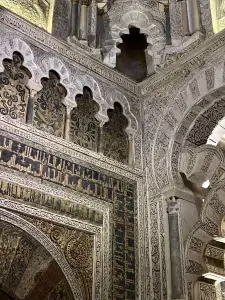

The Alcázar of the Christian Monarchs
A must-see in Cordoba is the Alcázar de los Reyes Cristianos. As its name suggests, the Alcázar was the residence of the Christian Monarchs during the Reconquista, and their headquarters during the planning of the conquest of Granada. Today, you can stroll through its historic rooms, lose yourself in the scent of the orange trees that decorate its impressive gardens and climb its towers. One of the most important towers is the Homenaje, which offers spectacular views, especially at sunset. Make sure you enjoy this experience to the fullest with the best team of professionals on our monumental tour of Córdoba.
The Jewish Quarter: Alleys steeped in history
The Jewish Quarter of Córdoba is one of the most beautiful and historic neighbourhoods in the city. Its narrow cobbled streets, white houses with flower-filled balconies and hidden corners will amaze you. As its name suggests, a prosperous Jewish community lived here during the Middle Ages, which is still reflected in the artistic legacy they left behind. One of the most photographed places in Córdoba is the Calleja de las Flores, which is sure to surprise you. Discover more with our guided tour of the Jewish Quarter of Córdoba.

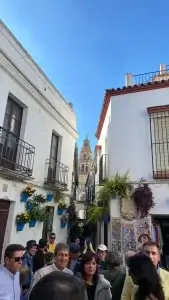
The Roman Bridge and the Calahorra Tower
Built in the 1st century BC, the Roman Bridge has witnessed the passage of Romans, Muslims and Christians over the centuries. From the bridge, you can see the whole city with the Mosque in the background, and at the end stands the Calahorra Tower, an ancient defensive fortress that houses a museum dedicated exclusively to the coexistence of cultures in Al-Andalus.

Roman Temple: Remains of the ancient city
If you stroll through the modern centre of Cordoba, you will come across the columns of the ancient Roman Temple of Cordoba. This temple, built in the 1st century AD, was part of the city’s forum. The characteristic white Corinthian columns hinted at the majesty of the temple. Immerse yourself in the past and its history by walking in the same places as people did twenty centuries ago.
Day 2: Explore the modern and natural sides of Cordoba in two days
After immersing yourself in the history and tradition of Cordoba on the first day, it’s time to discover the more modern side of the city and experience its local essence. From peaceful parks where you can take a break to the most commercial neighbourhoods. Let yourself be seduced by the impressive cuisine while enjoying the Cordoba sunshine on one of the most typical terraces.
The Viana Palace
The Palacio de Viana consists of 12 carefully preserved courtyards where history and beauty have flourished over the centuries. This majestic palace complex offers a tour full of colour, water and tranquillity. Apart from the courtyard, the palace houses a huge collection of tapestries and furniture that, together with its rooms, will tell you what life was like for the Cordoba aristocracy between the 15th and 19th centuries. The ideal time for this visit is in spring, when the gardens are in full bloom, making it even more special.
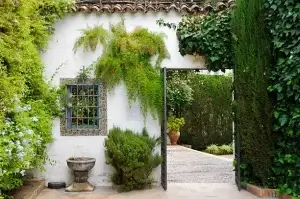
La Plaza de las Tendillas
La Plaza de las Tendillas is surrounded by elegant buildings, cafés and shops, making it the ideal place to stop between visits. It is often a meeting point for the people of Cordoba themselves to go out for a while, so you will feel like one of the locals. The sound of the Tendillas clock, which marks the hours with flamenco guitar chords, adds a lively touch to the atmosphere. Next door you will find the most iconic streets, such as Calle Cruz Conde, from where tourist routes to the historic centre usually depart. You are also very likely to come across a street performance that will show you a good time.
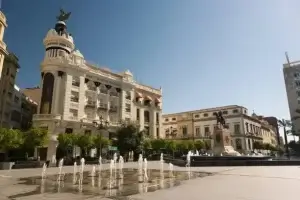
The Synagogue of Cordoba
Located in the heart of the Jewish quarter, the Synagogue of Córdoba is one of the few remaining examples of medieval synagogues in Spain. Built in the 14th century, its interior features beautiful Mudejar plasterwork with Hebrew inscriptions and geometric decorations. In its day, it was a place of worship, then a school and finally a hospital. Today it is a National Monument and can be visited free of charge. Next to it is the statue of Maimonides, one of the most renowned scholars of Judaism.
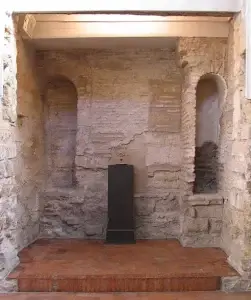
The Patios of Cordoba
The patios of Cordoba are one of the city’s greatest charms. Behind the white doors lie amazing vertical gardens full of colour. Every spring, during the famous Patios Festival, residents open their homes to show tourists the spaces decorated with flowers, fountains and potted plants. The festival is held in May, but the patios can be visited throughout the year. Get to know them better with our guided tour of the patios of Cordoba.

Arruzafa Park
If you’re looking to disconnect a little, Arruzafa Park is the ideal place. Located in one of the quietest areas of Cordoba, its name comes from the old Andalusian palace that once stood in this area. Today, it is a large park with shaded paths, benches and diverse vegetation. It is usually frequented by families, sports enthusiasts and tourists looking to relax a little. There are also picnic areas, so the ideal plan is to spend the morning there and have lunch while enjoying the scenery.
Useful tips before visiting Córdoba in two days
How to get around Córdoba in two days
Córdoba is an ideal city to explore on foot, especially its historic centre, which is largely pedestrianised. All the attractions are very close together, so there is no need to use public transport. For longer distances, you can use the city buses or hire a bicycle. In the more modern areas, you will also find electric scooters. As a tip, avoid driving, as parking is limited and the streets are very narrow.
Best time of year to visit Córdoba
Spring, especially April and May, is the best time to visit the city, especially if you are planning a family holiday with children in Córdoba. The weather is pleasant, the days are longer and the city is filled with colour and fragrance thanks to the Festival de los Patios and the Cruces de Mayo. It is not advisable to visit in summer due to the high temperatures. Autumn is also a good option if you want a quieter time, as there are fewer tourists at this time of year.
Food tips
Córdoba is known for its gastronomic variety and rich traditional cuisine. You can’t leave the city without trying salmorejo, aubergines with honey or flamenquín. To enjoy them to the fullest, head to local taverns in neighbourhoods such as San Basilio or La Judería. Don’t forget to accompany your meals with a Montilla-Moriles wine, typical of the region. And if you go in summer, ask for a refreshing ‘fresquito cordobés’.

Where to stay in Córdoba for two days
If you’re looking for accommodation in Córdoba, the best place to stay is in the historic centre, as you’ll be able to reach the main monuments quickly and easily on foot. There’s a wide range of options depending on your budget and the type of accommodation you’re looking for: from boutique hotels and hostels to tourist hostels and apartments. If you are looking for a quieter area, the San Lorenzo neighbourhoods or the Arruzafa area are ideal. It is advisable to book in advance if you are coming in spring, as this is the high season due to local festivals.
Extra activities if you have time
If you are an active person and, apart from visiting the main monuments, you want to do more activities, you are in luck, as Cordoba offers a wide variety to suit all tastes. We recommend a relaxing bath in an Arab hammam, a boat trip on the Guadalquivir River or a free tour of the mysteries and legends of Cordoba. If you prefer nature, don’t miss the Cruz Conde Park or the Botanical Gardens. And if shopping is your thing, the Municipal Souk or the Victoria Market are the perfect options. And if you’re the type who likes to collect souvenirs, here’s a post about the best gifts and souvenirs from Cordoba.

FAQ
What to see in Cordoba in two days for free?
You can visit the Mosque-Cathedral from the outside, stroll through the Jewish quarter, admire the Roman Bridge, explore the courtyards open to the public and enjoy squares such as Las Tendillas and La Corredera. There are also museums with free admission at certain times and on certain days. To find out more, sign up for our free tour of Córdoba.
Can you visit Córdoba in two days without a car?
Yes, no problem. The historic centre is compact and designed for walking. Most monuments and places of interest are just a few minutes away from each other. There are also city buses and taxis if you need to travel to more distant areas such as Medina Azahara or La Arruzafa.
Do I need to book restaurants if I’m only visiting Córdoba for two days?
It depends on the season. In spring and at weekends, it is advisable to book, especially in popular or more central restaurants. If you go without a reservation, we recommend looking for taverns further away from the tourist centre, where there is usually more availability without the need to book.
Would you like to discover more with our best tourist guides in Córdoba? Don’t hesitate to contact us!
Visit Córdoba in two days
When you only have a weekend to visit a city with such an important historical heritage as Córdoba, it is absolutely necessary to plan well in advance to make the most of the limited time available, as we must not forget that Córdoba is the only city in the world that currently has four UNESCO World Heritage Sites: the Mosque-Cathedral, most of the historic centre, the Patios and the recently named Madinat al-Zahra.
Let’s go on a Free Tour
In these cases, it is always highly recommended to take our Free Tour in Córdoba, as it will give you a good overview of the most monumental parts of Córdoba, including part of the Axerquía (the least known part of our historic centre) and the city’s Roman heritage.
A must
Before lunch, we recommend visiting the Mosque of Córdoba, built on the remains of the Visigothic basilica of San Vicente Mártir. Inside, you can marvel at the forest of columns, the Byzantine mosaics, the primitive Main Chapel, the Royal Chapel and see the stylistic clash between Islamic and Christian art, especially in the Cathedral. Here, we should pay special attention to the main altarpiece and its impressive choir stalls. The famous Patio de los Naranjos (Courtyard of the Orange Trees) was the old ablution courtyard of the mosque. Walking through it will bring to mind the verses of Ricardo Molina, who described it as an ‘island of shade, silence and perfume’.
Through the Jewish quarter…
In the afternoon, after lunch, we can stroll along Calle del Pañuelo and Calle de las Flores. We will continue into the Jewish quarter and visit the synagogue, built in 1315, making it the oldest in Andalusia. We will also pass through the Zoco to admire its beautiful Cordoban courtyard and from there we will go to Calle Kairúan to head towards the Alcázar de los Reyes Cristianos, the former residence of the great emirs and caliphs of Cordoba and where the Catholic Monarchs themselves later decided to reside. Its gardens are a delight for the senses, and it is also very interesting to visit the Mosaic Room, climb the two towers and see the Mudejar baths (built in the 14th century by order of King Alfonso XI).
A new day
The next day, an excellent option is to visit the Shining City. For more information, click on the following link: Guided tour of Medina Azahara. The palatine city was built by the first caliph, Abderramán III, in the first half of the 10th century as a symbol of the newly established caliphate in the West. Medina Azahara is an archaeological site of world renown and is located just 8 km from the current capital. In the auditorium of the visitor centre, you can see a virtual reconstruction of what the city originally looked like, and the museum has a comprehensive selection of artefacts, making it well worth a visit.
After lunch and a short rest, the afternoon of this second day would be an excellent opportunity to visit some of the most award-winning patios in the history of the competition, which is always held during the first two weeks of May. Outside the competition, only six of the courtyards in the San Basilio neighbourhood, located next to the Alcázar of Cordoba, are open to the public, but believe us when we say that they are six of the most beautiful courtyards in the city.
Finally…
If you still have some energy left, we can end our trip by visiting the Renaissance-style Palacio de Viana: a 15th-century building that was inhabited until the 1980s and inside which we will be absorbed by its 12 stately courtyards, the collection of tapestries, the library, the original furniture, the collection of Cordoban and Guadamecí leatherwork, firearms, Mudejar coffered ceilings… Without a doubt, the Palacio de Viana would be a fitting way to end our getaway in Cordoba.
With all these recommendations, we are convinced that you will be pleasantly surprised and, above all, that you will gain an in-depth knowledge of Cordoba’s historical and artistic heritage: have a good trip!

